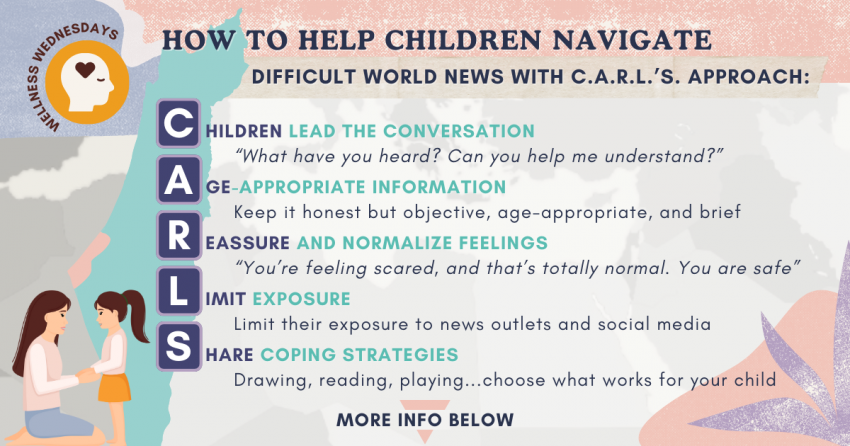Have your children begun to ask some tough questions about the Israel-Palestine crisis that is making daily headlines? We want to protect our children from the harsh realities of the world, but they often pick up tidbits of information from news outlets, social media, adult conversations, or peers. Because they cannot process horrific images and difficult news the way we can, it’s vital that their fears and anxieties are addressed if they have been exposed to it. If you find yourself facing this challenge, C.A.R.L.’S. approach offers some tips to help support your children:
- Children Lead the Conversation: “What have you heard? Can you help me understand?”
- Age-Appropriate Information: Keep it honest but objective, age-appropriate, and brief
- Reassure and Normalize Feelings: “You’re feeling scared, and that’s totally normal. You are safe.”
- Limit Exposure: Limit their exposure to news outlets and social media
- Share Coping Strategies: Drawing, reading, playing…choose what works for your child
Providing age-appropriate information is essential when discussing sensitive topics with children of different age groups. Here are some general guidelines on how you might explain the current crisis to children aged 5 to 12:
For 5-7-year-olds: Keep the conversation very simple and focus on providing reassurance.
“There’s a place far away where some people are having a really hard time. But you are safe here, and we love you. We’re always here to protect you and answer your questions.”
For 8-10-year-olds: At this age, children can handle a bit more information but still need reassurance and simplicity.
“There are two places called Israel and Palestine that are going through some tough times, and it’s making the people there feel very sad and worried. But it’s far away from us. You’re safe here, and we’re always here to protect and help you.”
For 11-12-year-olds: Older children can handle a bit more complexity in their explanations.
“There’s a conflict happening between the people of Israel and Palestine, and it’s causing a lot of difficulties and worries for the people there. It’s important to know that these problems are happening far away from us, and that you are safe here. We can talk more about this if you’d like, and explore why these things happen in the world.”
In all cases, it’s crucial to emphasize their safety and your support while keeping the information at an age-appropriate level. Encourage them to ask questions and express their feelings so you can address their concerns and provide guidance accordingly. Monitor their emotional responses and adjust the conversation as needed. Remember that you are not supposed to be an expert on the issue. Your priority is fulfilling the emotional and psychological needs of your child(ren).
When talking about this or any other world crisis, be careful not to oversimplify and make general statements about an entire group of people. Instead of trying to explain a 75 year long ongoing conflict that will leave children feeling helpless without a resolution, focus on the idea of conflict resolution and what happens when you don’t resolve conflict. The next comment offers an example of how you can start the conversation in a way young children can understand:
“Having disagreements with others is quite common. When that happens, it’s important to work together to solve the disagreement so it doesn’t get worse. What works best is to find common ground – something we can all agree on. For example, we all deserve to have a place to live, so we need to find a way to allow everyone to have a place to live. For a very long time in some places, people have disagreed on who should live where, who owns what, and who should be in charge. When adults can’t work together to find a solution, they get angry with one another and sometimes start fighting. Whenever adults fight, kids get stuck in the middle because they have nothing to do with the fight and can’t do anything to stop it. The only way to better understand each other is for us to learn how to resolve conflicts by seeking common ground, and always remember that what matters more than anything else is that people don’t get hurt.”
Help them understand the difference between being shocked, worried, and scared. They are shocked by what they hear, and can be worried about what is happening, but there is no reason to be scared.
If talking about it doesn’t feel like it’s enough, families can choose to support organizations that focus on helping children. UNICEF and Save The Children are two examples. Keep in mind that relief organizations can do more if they are given money that is not earmarked for a specific conflict. Your contribution is also more impactful when it is donated to one organization instead of spread out over several. Once you’ve donated what you feel comfortable with, tell yourself that this is the best thing you can do and that you’ve now done what you can. Otherwise you’ll always feel like you need to donate more and it becomes a moral downward spiral.
The most important take-away is to reassure your child(ren)’s safety and security, and help preserve their innocent belief that a future of peace is possible. Because it’s only possible if they continue to believe 
